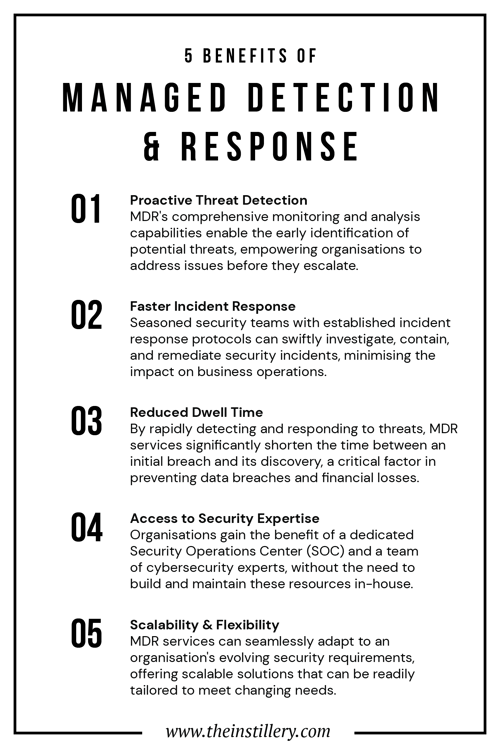As organisations grapple with a relentless barrage of sophisticated cyber threats, the limitations of traditional security measures have become increasingly apparent. The once-reliable defences against malicious actors are struggling to keep pace with the rapid evolution of attack methods. In this climate of heightened digital risk, a transformative solution emerges, Managed Detection and Response (MDR) services.
MDR offers a dynamic and comprehensive approach to safeguarding organisations, blending advanced threat detection, real-time incident response, and security expertise. By leveraging this innovative approach, businesses can fortify their cyber defences and confidently navigate the shifting cybersecurity landscape.
In this article, we dissect the essence of MDR, unveiling its critical role in bolstering organisational security. Whether you're a seasoned professional or a newcomer, this guide equips you with the knowledge to navigate the intricacies of MDR effectively.
Defining Managed Detection & Response (MDR) Services
At the heart of the MDR approach lies the recognition that proactive, round-the-clock vigilance is essential in the face of today's sophisticated cyber threats. MDR services combine advanced security technologies, expert-led analysis, and rapid incident response to provide a comprehensive solution for organisations seeking to fortify their defences.
Unlike traditional security measures that primarily focus on perimeter-based protection, MDR services adopt a multi-layered strategy that extends far beyond the network's edge. By continuously monitoring for anomalies, analysing threat intelligence, and swiftly acting on detected incidents, MDR providers empower organisations to detect, investigate, and mitigate threats before they can inflict significant damage. To delve deeper into the evolution of MDR services, be sure to read our related blog, "Understanding the Evolution of Managed Detection & Response Services".
The Key Components of Effective MDR
Effective MDR services are built upon a foundation of interconnected capabilities, each playing a crucial role in the overall security framework:
- Continuous Monitoring & Response: The bedrock of an effective MDR service is the 24/7 Managed Security Operations Center (SOC) and the powerful capabilities of Security Orchestration, Automation, and Response (SOAR) platforms. By combining round-the-clock vigilance and automated threat mitigation, these components ensure that security incidents are detected and addressed swiftly, minimising the potential for data breaches or operational disruptions.
- Threat Detection: MDR providers leverage cutting-edge security technologies, including AI-powered analytics and behavioural monitoring, to identify potential threats and anomalies in real-time.
- Security Analytics: Advanced data analysis and threat intelligence gathering enable MDR providers to uncover patterns, trends, and emerging threats, allowing for proactive risk mitigation.
- Threat Intelligence: By continuously aggregating and analysing threat data from various sources, MDR services stay ahead of the curve, enhancing their ability to detect and neutralise sophisticated cyber attacks.
The Five Benefits of Adopting MDR
As organisations navigate the increasingly treacherous cybersecurity landscape, the adoption of MDR services has emerged as a strategic imperative. By entrusting their security to a specialised MDR provider, organisations can unlock a host of tangible benefits:

Enhancing Cybersecurity with the MDR-Zero Trust Combo
The synergetic integration of Managed Detection and Response (MDR) and the Zero Trust security model has emerged as a powerful approach to fortifying cybersecurity defences. In our blog, "The Dynamic Duo: How MDR and Zero Trust Elevate Cybersecurity," we explore how these two security strategies work in tandem to deliver a multi-layered defence that is both proactive and adaptive. From threat hunting and incident response to behavioural analytics and micro-segmentation, the combination of MDR and Zero Trust offers comprehensive protection against even the most sophisticated cyber threats.
The Future of MDR: Predictions & Trends
As the digital landscape continues to evolve, Managed Detection and Response (MDR) services are poised for transformative change. From the alarming surge in ransomware attacks to the growing adoption of MDR services, we delve into the critical factors driving this evolution. We also examine the pivotal role of artificial intelligence (AI) in enhancing threat detection capabilities and uncover the unsettling impact of social media on the cybercrime ecosystem.
By staying informed about these emerging trends, you can make more strategic decisions about leveraging MDR services to strengthen your organisation's security posture and stay ahead of the curve. Check out our linked article for more.
Conclusion
Managed Detection and Response services offer a robust and dynamic solution, empowering businesses to stay ahead of the curve and safeguard their critical assets. By leveraging the comprehensive capabilities of MDR, organisations can enhance their threat detection, accelerate incident response, and access the expertise of dedicated security professionals. This strategic approach not only strengthens their cybersecurity posture but also enables them to navigate the evolving digital landscape with increased confidence and resilience.
As you consider the implementation of MDR services within your organisation, remember that the right provider can be a transformative partner in your cybersecurity journey. Take the time to evaluate your options, align with your specific needs, and unlock the power of Managed Detection and Response to fortify your defences against the relentless onslaught of cyber threats.

2 Apr 2024




